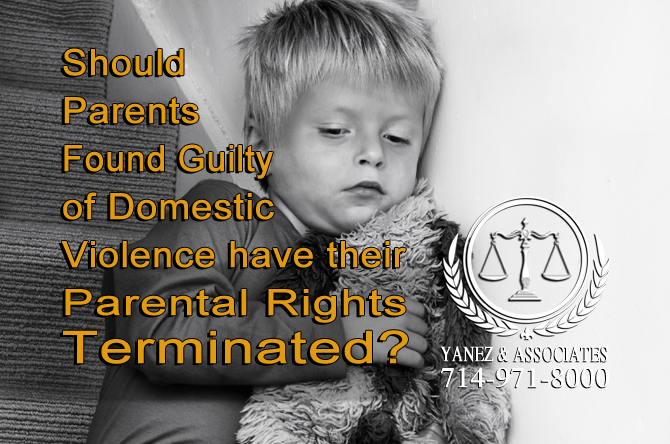First Place winner of the 2015 Annual Family Law Scholarship Essay Contest and Scholarship Program for Law Students: Samantha Sobel, Stetson University College of Law
Should Parents Found Guilty of Domestic Violence have their Parental Rights Terminated?
I. An Illustration
“You better not touch [him] or I will kill you.”1 Arlena Lindley grabbed her son anyway, trying to leave together.2 But, when her boyfriend, Alonzo Turner, allowed her to leave his apartment, he took back her three-year-old son, who was the object of his cruelty that day.3 Lindley had been with a neighbor as they watched Turner strike Lindley’s son multiple times with a belt after having defecated on himself.4 Then, Turner pushed Lindley’s son’s face into the oatmeal that he had vomited on to the floor, kicked him, picked him up by his neck, and put his face into the toilet while flushing it.5 Both Lindley and the neighbor were scared as they watched this scene, but Turner’s threats would keep both women from getting in the way to stop Turner’s blows.6 The neighbor and Lindley went to call for help, but Lindley knew better than to call the police. She returned to the apartment, and Turner instructed her to go with the neighbor and buy groceries, giving her money.7 Lindley did as she was told. When she came back, her son complained that he was tired and his stomach hurt.8 Without a mode of transportation, Turner refused to let Lindley use his phone to call an ambulance, telling her that if her son went to the hospital, he would be arrested.9 After putting away the groceries, Lindley went back into her son’s room only to find that her toddler was no longer breathing.10
While the facts differ in cases that involve intimate partner violence, one common theme remains: a parent that is being controlled and overpowered by their significant other is charged for the failure to protect their child and runs the risk of having their parental rights terminated. Even when it is obvious that the parent has been stripped of their independence by their abuser they are forced to ask for money because they are not allowed to have a job, they do not have a phone, they do not have transportation, and they have nowhere to go because people don’t want to get involved- they are still expected to get up and leave their abuser, regardless of the imminent threats to kill them, their children, and their family.
In Juvenile Dependency cases involving domestic violence, it is so important that as practitioners and advocates, we are aware that there is much more below the surface than just a verbal or physical argument between parents; there is power, control, and manipulation. It is because of the complexity of each case involving domestic violence that the Courts must evaluate the totality of the circumstances, as well as explore other avenues to help the child and their family, rather than a “per se” termination of parental rights standard. To permanently deprive a parent of their fundamental right to care for their child should not be taken lightly, and in most cases, should be used as a last resort tactic to ensure the safety and wellbeing of the child.
II. Domestic Violence: A Look Below the Surface

Should Parents Found Guilty of Domestic Violence have their Parental Rights Terminated? For more information consult with a restraining order lawyer!
Domestic violence is defined as “the willful intimidation, physical assault, battery, sexual assault, and/or other abusive behavior as a part of a systematic pattern of power and control perpetrated by one intimate partner against another.”11 It is not only characterized by physical and sexual violence, but also by threats and emotional abuse.12 Domestic violence is more than what appears on the surface, and an understanding of the key phrase “systematic pattern of power and control”13 is necessary in every case.
Intimate partner or domestic violence is unlike most other crimes in that it is “not a sudden, isolated, and unexpected incident.”14 Many times it involves “years of emotional and psychological trauma as well as physical injuries which may become increasingly more severe and occur frequently over time.”15 The victim is not able to easily walk away from this type of abusive relationship because of the reality that their abuser may “follow through with the threats they have used to keep them trapped: the abuser will hurt or kill them, they will hurt or kill the kids, they will win custody of the children … or they will ruin their victim financially…”16 In fact, the most dangerous time for a victim of domestic violence is when they try to leave the abuser.17
When reaching below the surface of domestic violence relationships, one can see that terminating a parent’s rights would not adequately address the needs of both parents- the abuser and the victim, nor would it be the least restrictive means to protect the child that has been exposed to the intimate partner violence.
III. The Lesser Evil: Termination of Parental Rights versus Exposure to Domestic Violence
While the effects of childhood exposure to domestic violence have been the subject of much research over the years and has the potential to create both long and short-term complications in a child’s life, there is one ultimate question that remains to be seen: which is the lesser of the two evils— childhood exposure to domestic violence or permanent removal from their parents’ care?18
Children may be exposed to domestic violence in many ways, whether they are sitting in mom’s lap, are in her arms during an attack, or they are locked in another room only to hear the violence or see the after-effects.19 Whether children directly witness the abuse or not, living with domestic violence places them at “high risk for a range of effects on their emotional, social, and cognitive functioning.”20 Children may suffer emotional and behavioral problems differently depending on age, gender, and psychological development.21
In situations where a child is being exposed to intimate partner violence in the home, the juvenile court system often assumes removal from both the batterer and the victim is the most appropriate solution to serve the best interest of the child.22 However, children that have been subjected to a life with domestic violence are at a heightened risk to have lasting and destructive affects from the removal.23 Removal for these children may actually result in doing more harm then good.24 While state removal from one’s home is extremely difficult for any child, children that have been exposed to domestic violence oftentimes have taken on a role as “protector” or have become exceedingly attached to the non-violent parent. Because of this, removals for these children are “at a heightened risk for separation anxiety disorder and experience self-blame and anxiety about the safety of their parent.”25 Further, removal compromises the few things that may be stable in that child’s life when “their immediate universe is unpredictable and unsafe;”26 things such as their siblings, their school, their friends, and likely, their entire community will be turned upside down.27
Once the removal is complete, the trauma continues, especially when the child is placed in the foster care system. The view that removal and placement into the foster care system is a “short-term strategy for protecting children” and is one that is short lived.28
As noted by the court in Nicholson, data has also revealed that some children are more resilient than others, and most noteworthy, that not all children are negatively affected by exposure to domestic violence.29 Clinical psychologists have determined that many children who witness intimate partner violence “show no measurable negative effects.”30 About thirty-seven percent showed outcomes similar to or better than non-witnesses.31 With results from various studies differing as to what extent childhood exposure to domestic violence effect children, new studies are needed to examine “…. factors that protect children, including adult role models, community support, and strong mother-child relationships.”32
IV. Fundamental Right versus State Interest
The of issue of permanently removing a child from a parent guilty of domestic violence brings to light an age-old Constitutionality question: is state interference and permanent removal an infringement on that parent’s fundamental liberty interest to raise and care for their child?33 The United States Supreme Court has held that “parents have a fundamental right regarding the care and custody of their children …”34 The Due Process Clause of the Fourteenth Amendment states in part that “[n]o State shall … deprive any person of life, liberty, or property without due process of law.”35 When state action involves a liberty interest, especially an interest that is fundamental, courts must consider due process and whether the action of the state has resulted in an “unreasonable deprivation of a person’s life, liberty, or property rights.”36 State actions that have the likelihood of impinging on a person’s fundamental due process rights are subject to a strict scrutiny test, which is a difficult, but necessary, burden to meet.37 Strict scrutiny creates a presumption that government action is unconstitutional, thereby forcing the government to show an interest so compelling as to rebut that presumption.38 Regardless, States may intrude on parental rights to protect a child’s well-being under the parens patriae doctrine, including the child’s physical or mental health.39 But, the courts will still need to inquire as to “whether the government action is necessary, or the only or least burdensome way to achieve a compelling state interest …”40
Permanent removal of a child based on a domestic violence conviction is not the least burdensome way in achieving the state interest of protecting children from domestic violence exposure. Both parents’ and children’s rights need to be taken into account when determining the “least burdensome way” to achieve the state’s goal.41 After all, “children cannot be protected without protecting their caretakers as well, indicating that removal from the [parent]’s care does little to safeguard the combined rights and safety for both [victim] and child.”42 The Supreme Court has expressed little doubt that the “Due Process Clause would be offended ‘[i]f a State were to attempt to force the breakup of a natural family, over the objections of the parents and their children, without some showing of unfitness and for the sole reason that to do so was thought to be in the children’s best interest.’ ”43
V. Conclusion
To terminate a parent’s rights “per se” for being convicted of domestic violence ignores the Supreme Court’s intention to avoid the breakup of a natural family. An examination of the totality of the circumstances is needed to determine and utilize existing services and programs to address the underlying conditions beneath the surface of intimate partner violence. Additionally, permanently removing a child from a survivor of domestic violence further victimizes that parent. While childhood exposure to domestic violence has the ability to effect a child’s safety and wellbeing when left untreated, the effects of permanently removing an already fragile child from their parent or parents has the grave potential to do more harm than good. Juvenile and family courts have the ability to help victims leave abusive situations and to ensure stability and permanency for the child within their own family. As advocates for both the child and the parents in cases involving domestic violence, a more holistic approach needs to be utilized in evaluating what is truly in the best interest of the child brought into the Juvenile Dependency System. Nonetheless, as officers of the Court, it is becomes our duty to inform and educate Judges and Legislators as to the harm we have the potential to inflict on these children by permanently removing them from everything they know.
One thing most practitioners will agree on, whether the advocate of the state, child, or the parent, is that cases involving domestic violence vary greatly. The case used in the beginning of this essay illustrates egregious circumstances that can result from intimate partner violence- the abusive parent controlling every aspect of the victim parent’s life, which paralyzes the victim’s ability to protect their own child. Therefore, using a “per se” standard of terminating parents’ rights that are found guilty of domestic violence, without some type of case-by-case analysis, serves as an injustice to the children that Juvenile Dependency laws were designed to protect. To learn more about parents' rights you can learn more by reading the fathers' rights lawyers article.
1 Lindley v. Texas, 2010 WL 1076138 (Tex. App.- El Paso March 24, 2010).
2 Id.
3 Id.
4 Id.
5 Id.
6 Id.
7 Id.
8 Id.
9 Id.
10 Id.
11 Nat’l Coalition Against Domestic Violence, NCADV National Fact Sheet,
2 Id.
3 Id.
4 Id.
5 Id.
6 Id.
7 Id.
8 Id.
9 Id.
10 Id.
11 Nat’l Coalition Against Domestic Violence, NCADV National Fact Sheet,
http://www.ncadv.org/files/Domestic%20Violence%20Stylized--GS%20edits.pdf (accessed Aug. 24, 2015).
12 Id.
13 Id.
14 Office for Victims of Crime, Domestic and Family Violence, http://ovc.ncjrs.gov/topic.aspx?topicid=27#pub1 (accessed Aug. 30, 2015).
15 Id.
16 Nat’l Coalition Against Domestic Violence, What is Domestic Violence?, http://www.ncadv.org/needsupport/what-is-domestic-violence (accessed Aug. 31, 2015).
17 Id.
18 Margo Lindauer, Damned If You Do, Damned If You Don’t: Why Multii-Court-Involved Battered Mothers Just Can’t Win, 20 Am. U. J. Gender Soc. Policy & L. 797, 811 (2012); see Lois A. Weithorn, Protecting Children From Exposure to Domestic Violence: The Use and Abuse of Child Maltreatment, 53 Hastings L.J. 1, 26-27 (2001).
19 Justine A. Dunlap, Sometime I Feel Like A Motherless Child: The Error of Pursuing Battered Mothers for Failure to Protect, 50 Loy. L. Rev. 565, 570 nn. 50 (2004) (citing Janis Wolak & David Finkelhor, Children Exposed to Partner Violence, Partner Violence: A Comprehensive Review of 20 Years of Research 73 (Jana L. Jasinksi & Linda M. Williams eds., 1998)); see Weithorn, supra n. 18, at 82.
20 Weithorn, supra n. 18, at 85.
21 Id. at 88 (citing John W. Fantuzzo & Wanda K. Mohr, Prevelance and Effects of Child Exposure to Domestic Violence, 9 The Future of Children: Domestic Violence and Children 21, 28-29 (Winter 1999)).
22 Lindauer, supra n. 18, at 810; see Weithorn, supra n. 18, at 36 n.140.
23 Id. at 811.
24 Id.
25 Id.
26 Id.
27 Id. at 812.
28 Id.
29 see generally Nicholson v. Scoppetta, 820 N.E.2d 840 (N.Y. 2004); Melissa A. Trepiccione, At The Crossroads of Law and Social Science: Is Charging A Battered Mother With Failure to Protect Her Child An Acceptable Solution When Her Child Witnesses Domestic Violence?, 69 Fordham L. Rev. 1487, 1505 (2001).
30 Futures Without Violence, The Facts on Children’s Exposure to Intimate Partner Violence, http://www.futureswithoutviolence.org/userfiles/file/Fact%20sheet%20on%20Children%20Exposed%20to%20IPV%202013.pdf (accessed Aug. 31, 2015).
31 Id.
32 Trepiccione, supra n. 29, at 1506.
33 Id. at 1508; see Russell W. Galloway, Jr., Basic Substantive Due Process Analysis, 26 U.S.F. L. Rev. 625, 631 (1992) (quoting Meyer v. Nebraska, 262 U.S. 390, 399 (1923).
34 Id. at 1507 (citing Troxel v. Granville, 120 S.Ct. 2054, 2060 (2000); citing Pierce v. Soc’y of Sisters, 268 U.S. 510, 534-535 (1925); citing Meyer, 262 U.S. at 399).
35 Id. at 1508 (quoting U.S. Const. amend. XIV, § 1).
36 Id.; see Galloway, supra n. 33, at 630-632.
37 Id.; see Galloway, supra n. 33, at 638-642.
38 Id.; see Galloway, supra n. 33, at 638.
39 Id. at 1513-1514 (citing Prince v. Mass., 321 U.S. 158, 166-167 (1944); citing Parham v. J.R., 442 U.S. 584, 603 (1979)).
40 Id. at 1514; see Galloway, supra n. 33, at 638.
41 Id. at 1511 (citing Duchesne v. Sugarman, 556 F.2d 817, 825 (2d Cir. 1977)).
42 Id. at 1512-1513 (citing The Impact of Domestic Violence on Children: A Report to the President of the American Bar Association 4 (2d rev . prtg., 1994)).
43 Id. at 1517 (quoting Smith v. Org. of Foster Families for Equal. & Reform, 431 U.S. 816, 862-863 (1977) (Stewart, J., concurring)).











